NEETS Module 5 - Introduction to Generators and Motors
Pages i,
1-1,
1-11,
1-21,
1-31,
2-1,
2-11,
3-1,
3-11,
4-1,
4-11, Index
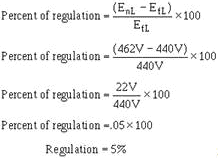
Note: The lower the percent of regulation, the better the generator. In the above example, the 5%
regulation represented a 22-volt change from no load to full load. a 1% change would represent a change of 4.4
volts, which, of course, would be better. Q20. What term applies to the voltage variation from no-load
to full-load conditions and is expressed as a percentage? Voltage CONTROL
Voltage control is either (1) manual or (2) automatic. In most cases the process involves changing the resistance
of the field circuit. By changing the field circuit resistance, the field current is controlled. Controlling the
field current permits control of the output voltage. The major difference between the various voltage control
systems is merely the method by which the field circuit resistance and the current are controlled. Voltage
REGULATION should not be confused with Voltage CONTROL. As described previously, voltage regulation is an internal
action occurring within the generator whenever the load changes. Voltage control is an imposed action, usually
through an external adjustment, for the purpose of increasing or decreasing terminal voltage.
Manual Voltage Control
The hand-operated field rheostat, shown in figure 1-21, is a typical example of manual voltage control. The field
rheostat is connected in series with the shunt field circuit. This provides the simplest method of controlling the
terminal voltage of a dc generator.
1-21
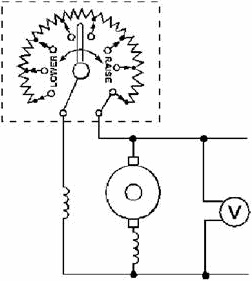
Figure 1-21. - Hand-operated field rheostat. This type of field rheostat contains tapped resistors with leads to a multiterminal switch. The arm of
the switch may be rotated to make contact with the various resistor taps. This varies the amount of resistance in
the field circuit. Rotating the arm in the direction of the LowER arrow (counterclockwise) increases the
resistance and lowers the output voltage. Rotating the arm in the direction of the RAIsE arrow (clockwise)
decreases the resistance and increases the output voltage. Most field rheostats for generators use
resistors of alloy wire. They have a high specific resistance and a low temperature coefficient. These alloys
include copper, nickel, manganese, and chromium. They are marked under trade names such as Nichrome, Advance,
Manganin, and so forth. Some very large generators use cast-iron grids in place of rheostats, and motor-operated
switching mechanisms to provide voltage control. 1-22
Automatic Voltage Control Automatic voltage control may be used where load
current variations exceed the built-in ability of the generator to regulate itself. An automatic voltage control
device "senses" changes in output voltage and causes a change in field resistance to keep output voltage constant.
The actual circuitry involved in automatic voltage control will not be covered in this chapter. Whichever
control method is used, the range over which voltage can be changed is a design characteristic of the generator.
The voltage can be controlled only within the design limits. PARALLEL Operation of GENERATORS
When two or more generators are supplying a common load, they are said to be operating in parallel. The purpose of
connecting generators in parallel is simply to provide more current than a single generator is capable of
providing. The generators may be physically located quite a distance apart. However, they are connected to the
common load through the power distribution system. There are several reasons for operating generators in
parallel. The number of generators used may be selected in accordance with the load demand. By operating each
generator as nearly as possible to its rated capacity, maximum efficiency is achieved. a disabled or faulty
generator may be taken off-line and replaced without interrupting normal operations. Q21. What term
applies to the use of two or more generators to supply a common load?
AMPLIDYNES Amplidynes are special-purpose dc generators. They supply large dc currents, precisely controlled, to
the large dc motors used to drive heavy physical loads, such as gun turrets and missile launchers.
The amplidyne is really a motor and a generator. It consists of a constant-speed ac motor (the prime mover)
mechanically coupled to a dc generator, which is wired to function as a high-gain amplifier (an amplifier is a
device in which a small input voltage can control a large current source). For instance, in a normal dc generator,
a small dc voltage applied to the field windings is able to control the output of the generator. In a typical
generator, a change in voltage from 0-volt dc to 3-volts dc applied to the field winding may cause the generator
output to vary from 0-volt dc to 300-volts dc. If the 3 volts applied to the field winding is considered an input,
and the 300 volts taken from the brushes is an output, there is a gain of 100. Gain is expressed as the ratio of
output to input:

In this case 300 V ÷ 3 V = 100. This means that the 3 volts output is 100 times larger than the input.
The following paragraphs explain how gain is achieved in a typical dc generator and how the modifications making
the generator an amplidyne increase the gain to as high as 10,000. The schematic diagram in figure 1-22
shows a separately excited dc generator. Because of the 10- volt controlling voltage, 10 amperes of current will
flow through the 1-ohm field winding. This draws 100 watts of input power (P = IE).
1-23
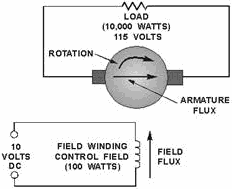
Figure 1-22. - Ordinary dc generator. Assume that the characteristics of this generator enable it to produce approximately 87 amperes of
armature current at 115 volts at the output terminals. This represents an output power of approximately 10,000
watts (P = IE). You can see that the power gain of this generator is 100. In effect, 100 watts controls 10,000
watts.
An amplidyne is a special type of dc generator. The following changes, for explanation purposes, will convert the
typical dc generator above into an amplidyne. The first step is to short the brushes together, as shown in
figure 1-23. This removes nearly all of the resistance in the armature circuit.
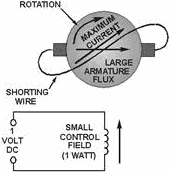
Figure 1-23. - Brushes shorted in a dc generator. Because of the very low resistance in the armature circuit, a much lower control-field flux produces
full-load armature current (full-load current in the armature is still about 87 amperes). The smaller control
1-24
field now requires a control voltage of only 1 volt and an input power of 1 watt (1 volt across 1 ohm causes 1
ampere of current, which produces 1 watt of input power). The next step is to add another set of brushes.
These now become the output brushes of the amplidyne. They are placed against the commutator in a position
perpendicular to the original brushes, as shown in figure 1-24. The previously shorted brushes are now called the
"quadrature" brushes. This is because they are in quadrature (perpendicular) to the output brushes. The output
brushes are in line with the armature flux. Therefore, they pick off the voltage induced in the armature windings
at this point. The voltage at the output will be the same as in the original generator, 115 volts in our example.
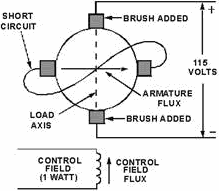
Figure 1-24. - Amplidyne load brushes. As you have seen, the original generator produced a 10,000-watt output with a 100-watt input. The
amplidyne produces the same 10,000-watt output with only a 1-watt input. This represents a gain of 10,000. The
gain of the original generator has been greatly increased. As previously stated, an amplidyne is used to
provide large dc currents. The primary use of an amplidyne is in the positioning of heavy loads through the use of
synchro/servo systems. Synchro/servo systems will be studied in a later module. Assume that a very large
turning force is required to rotate a heavy object, such as an antenna, to a very precise position. a low-power,
relatively weak voltage representing the amount of antenna rotation required can be used to control the field
winding of an amplidyne. Because of the amplidyne's ability to amplify, its output can be used to drive a powerful
motor, which turns the heavy object (antenna). When the source of the input voltage senses the correct movement of
the object, it drops the voltage to zero. The field is no longer strong enough to allow an output voltage to be
developed, so the motor ceases to drive the object (antenna).
The above is an oversimplification and is not meant to describe a functioning system. The intent is to show a
typical sequence of events between the demand for movement and the movement itself. It is meant to strengthen the
idea that with the amplidyne, something large and heavy can be controlled very precisely by something very
small, almost insignificant. Q22. What is the purpose of a dc generator that has been modified to
function as an amplidyne?
1-25
Q23. What is the formula used to determine the gain of an amplifying device?
Q24. What are the two inputs to an amplidyne?
Safety PRECautionS You must always observe safety precautions when working around electrical equipment to avoid injury to
personnel and damage to equipment. Electrical equipment frequently has accessories that require separate sources
of power. Lighting fixtures, heaters, externally powered temperature detectors, and alarm systems are examples of
accessories whose terminals must be deenergized. When working on dc generators, you must check to ensure that all
such circuits have been de-energized and tagged before you attempt any maintenance or repair work. You must also use the greatest care when working on or near the output terminals of dc generators.
Summary This chapter introduced you to the basic principles concerning direct current generators. The different
types of dc generators and their characteristics were covered. The following information provides a summary of the
major subjects of the chapter for your review. Magnetic INDUCTION takes place when a
conductor is moved in a magnetic field in such a way that it cuts flux lines, and a voltage (EMF) is induced in
the conductor. The LEFT-Hand RULE for GENERATORS states that when the thumb, forefinger,
and middle finger of the left hand are extended at right angles to each other so that the thumb indicates the
direction of movement of the conductor in the magnetic field, and the forefinger points in the direction of the
flux lines (north to south), the middle finger shows the direction of induced EMF in the conductor.
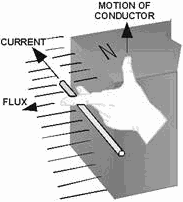 1-26
AN ELEMENTARY GENERATOR consists of a single coil rotated in a magnetic field. It
produces an ac voltage.
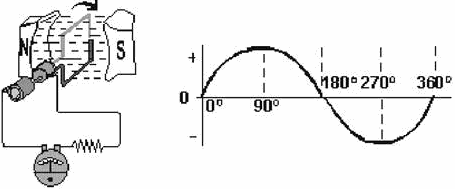
A Basic DC GENERATOR results when you replace the slip rings of an elementary generator
with a two-piece commutator, changing the output voltage to pulsating dc.
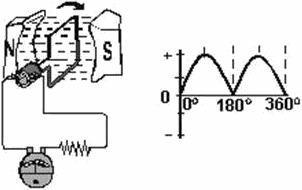
A MULTIPLE COIL ARMATURE (adding coils to the armature) decreases the ripple voltage in
the output of a dc generator, and increases the output voltage.
1-27
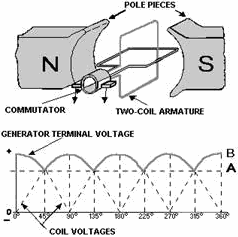 A MULTIPOLE GENERATOR is the result of adding more field poles to a dc generator. They
have much the same effect as adding coils to the armature. In practical generators, the poles are electromagnets.
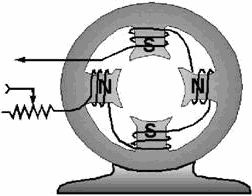
COMMUTATION is the process used to get direct current from a generator. The coil
connections to the load must be reversed as the coil passes through the neutral plane. The brushes must be
positioned so that commutation is accomplished without brush sparking.
1-28
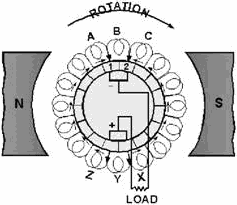
ARMATURE REACTION takes place when armature current causes the armature to become an
electromagnet. The armature field disturbs the field from the pole pieces. This results in a shift of the neutral
plane in the direction of rotation.
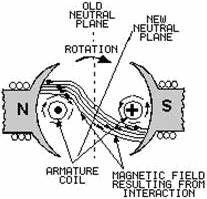
COMPENSATING WINDINGS and INTERPOLES are used to counteract the effects of armature
reaction. They are supplied by armature current and shift the neutral plane back to its original position. 1-29
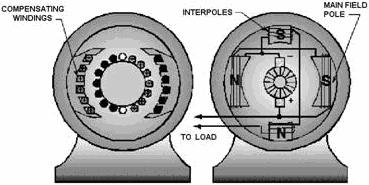 MOTOR REACTION is caused by the magnetic field that is set up in the armature. It tends
to oppose the rotation of the armature, due to the attraction and repulsion forces between the armature field and
the main field.
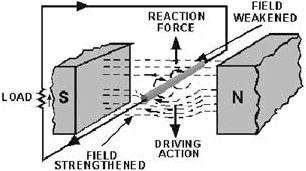
ARMATURE LOSSES in dc generator armatures affect the outputs. These losses are as
follows: 1. Copper losses are simply I2R (heat) losses caused by current flowing through the
resistance of the armature windings. 2. Eddy currents are induced in core material and cause heat.
3. Hysteresis losses occur due to the rapidly changing magnetic fields in the armature, resulting in heat.
1-30
| - |
Matter, Energy,
and Direct Current |
| - |
Alternating Current and Transformers |
| - |
Circuit Protection, Control, and Measurement |
| - |
Electrical Conductors, Wiring Techniques,
and Schematic Reading |
| - |
Generators and Motors |
| - |
Electronic Emission, Tubes, and Power Supplies |
| - |
Solid-State Devices and Power Supplies |
| - |
Amplifiers |
| - |
Wave-Generation and Wave-Shaping Circuits |
| - |
Wave Propagation, Transmission Lines, and
Antennas |
| - |
Microwave Principles |
| - |
Modulation Principles |
| - |
Introduction to Number Systems and Logic Circuits |
| - |
- Introduction to Microelectronics |
| - |
Principles of Synchros, Servos, and Gyros |
| - |
Introduction to Test Equipment |
| - |
Radio-Frequency Communications Principles |
| - |
Radar Principles |
| - |
The Technician's Handbook, Master Glossary |
| - |
Test Methods and Practices |
| - |
Introduction to Digital Computers |
| - |
Magnetic Recording |
| - |
Introduction to Fiber Optics |
| Note: Navy Electricity and Electronics Training
Series (NEETS) content is U.S. Navy property in the public domain. |
|






















